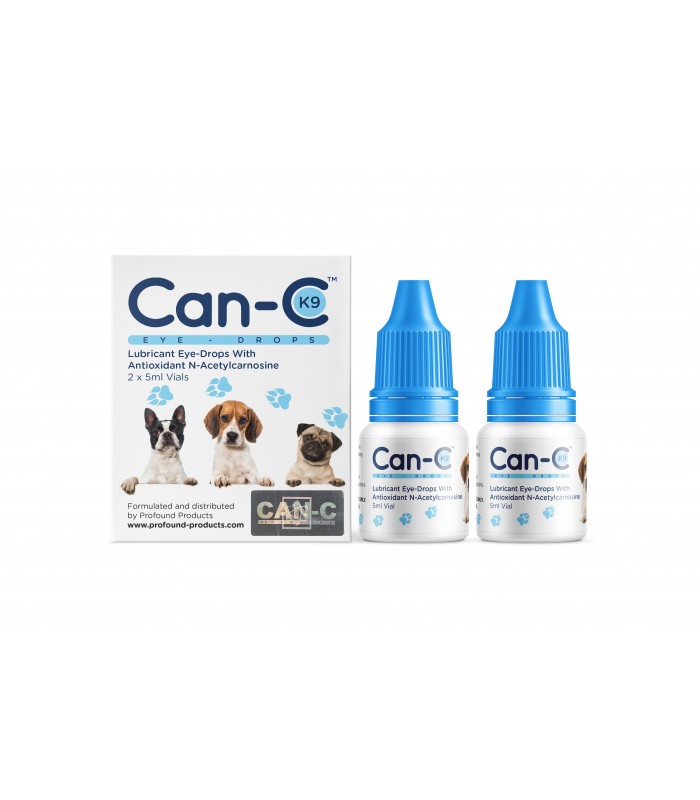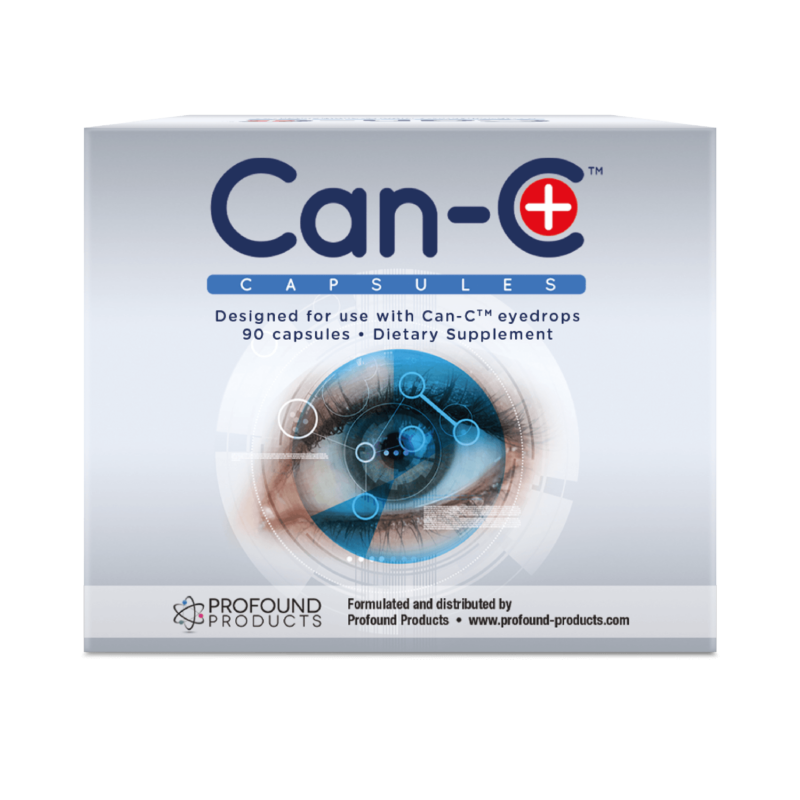Can-C is a remarkable breakthrough, an eye-drop that can reverse senile cataracts and help prevent other eye aging disorders
In the East, particularly in Russia, over the last several years, there has been research into a special analogue of the di-peptide carnosine. This particular form is known as N-acetylcarnosine and it has been proven to be highly effective in the treatment of cataracts.
Senile cataract surgery is the most commonly performed surgical operation in the world today. There are 1.35 million eye operations each year in the USA, and while cataract surgery is generally recognised as being one of the safest operations, there is a significant complication rate. For example, in the United States 30% to 50% of all patients having cataract extraction, develop opacification of the posterior lens capsule within two years and require further lazer treatment.
N-acetylcarnosine eye-drops provide treatment without surgery, and allow the patient to keep their natural lens rather than cope with an artificial one.
The statistics in the human trials show that N-acetylcarnosine eye-drops applied for 6-months twice daily into the eye, in patients all suffering from senile cataract, had the following results:
- 88.9% had an improvement of glare sensitivity.
- 41.5% had an improvement of the transmissivity of the lens.
- 90% had an improvement in visual acuity.
The pictures show the treatment of human cataract with the eye drops of 1% Can-C for the period of 5 months. The left image shows the appearance of cataract which resembles a bat in its form and the right image shows that this opacity has disappeared after the cited period after treatment with n-acetylcarnosine is completed. The lens has become clearer.
How does N-acetylcarnosine work in the eye:
Cataracts are caused by the hardening and discoloration of the lens due to lifelong cross-linking (glycosylation) of the lens proteins with ascorbate. This persists in the aqueous humor at high concentrations, due to the low availability of natural defenses in the form of anti-oxidants (which decline with advancing age).
N-acetylcarnosine delivers L-Carnosine into the aqueous humor of the eye (the fluid area surrounding the lens) where it acts as a natural and comprehensive anti-oxidant, protecting structural lens proteins from the free-radical induced oxidation process.
Using N-acetylcarnosine Eye-drops:
N-acetylcarnosine eye-drops have been shown to have measurable affects within only 1-month of use. However, it is recommended that for maximum efficacy, that administration be continued for a period not less than 3-5 months. In addition, the drops’ effectiveness is increased the sooner they are used after a cataract is detected.
Also, considering that senile cataracts are an on-going aging disorder. N-acetylcarnosine may be required on a regular basis to help maintain the eye’s natural anti-oxidant defenses.
Additional benefits:
Other than senile cataract, N-acetylcarnosine may have other benefits. Although the information is not yet published, the unique N-acetylcarnosine formula with its added and synergistic lubricants, could also provide beneficial results with the following eye-disorders:
- Presbyopia.
- Open-angle primary glaucoma (in combination with beta-blockers).
- Corneal disorders.
- Computer vision syndrome.
- Eye strain.
- Ocular inflammation.
- Blurred vision.
- Dry eye syndrome.
- Retinal diseases.
- Vitreous opacities and lesions.
- Complications of diabetes mellitus and other systemic diseases.
- Contact lens difficulties, particularly with soft contact lenses. (Not only do the lubricants in the Can-C N-acetylcarnosine eye-drop help to make wearing contact lenses more comfortable, but n-acetylcarnosine is also believed to reduce the build up of lactic acid in the eye, thus enabling the lens to be left safely in the eye for longer).
Can-C is the original, high purity, tested and approved brand. If you want assurances about what will work and what will be safe in your eye to use for months at a time, insist on Can-C eye-drops. Can-C is the brand approved and patented by Innovative Vision Products the inventors of this technology.
Further Information:
The discovery and 15-years of research with carnosine. We also recommend reading the latest article about N-acetylcarnosine eye-drops by clicking here.
Dosage:
As a preventative measure, two drops into both eyes once a day may be a suitable on-going regime. As for treatment, two drops into the affected twice daily is the ideal regime- there is no benefit in exceeding this dose. It is recommended that occasional use of N-acetylcarnosine eye-drops continue even after the reduction/reversal of the cataract to prevent any re-occurrence.
Side effects:
To date, no serious side effects or contraindications have been noted in any of the clinical trials.
What our customers say…
I thought it necessary to send this e-mail, hesitated a bit for which you will read, but had to send it on. I have received the four boxes of Can-C, have used them for four days, one drop in the left eye, the only “problem” eye. I almost hesitate to relate this, usually when you think something good happens, it almost ends when you tell it.
I felt immediate relief the very first day of using the drops, it was uncanny. Then I thought, maybe it was all mental, that I just wanted them to work for me. The second and on to the fourth day, it is difficult to tell you how the eye feels now without actually telling someone in person.
I was having extreme sensitivity to sunlight in the left eye, now it hardly bothers me. The eye had been feeling “swollen”, the lid that is, is best how I can describe it. It was difficult for me to look upward, I had to lower my head back to look up at anything. All this appears to be disappearing. I would just hate that it all goes away after telling you this, but I really don’t think it will.
My reason for going to see an Ophthalmologist was because I had “something” under that left lid. Once there, I was given a complete examination for cataracts, macular degeneration and glaucoma, he saw a slight beginning of a cataract and macular degeneration, the glaucoma was not mentioned. I have a six month appointment for next month. This doctor did absolutely nothing for the actual problem I went in for, simply told me to use a warm, moist compress on that left eye for 15 minutes, twice a day, but it did no good. I began using a salt solution instead, super saturated, and within two weeks that horrible feeling under the lid was gone. Oh, yes, he pulled that lid back and said to me, “I see a nodule or something like one, I could shave it down, but am positive it will grow back!” This is something a patient doesn’t want to hear. I essentially left there with no plan of treatment.
I have no actual loss of vision in that left eye, just a slight bit of cloudiness which you might expect for a forming cataract, but that didn’t bother me. I am 70 years old and more of less expected to have developed a cataract. He did not actually say that the left eye was the one with the forming cataract, I am simply assuming.
I am from a small town in Alabama and have told all my friends about what the drops have done is such a very short time. All of them have already had cataracts removed from both eyes by this very same doctor.
I know that maybe you do not want to say that the drops actually will dissolve the cataract, but I have a positive outlook that it will. I worked all my years as a research biochemist for a leading pharmaceutical company, so I am familiar with the medical terms and do know that the acetyl radical does take the carnosine through the membranes.
I am very excited about these drops and will use the four boxes and if I should need more for that right eye should it develop a cataract “down the road”, you can be assured I will place my order.
Thank you so much for these drops, you cannot imagine how much my well being has changed since using them only four days ago, that left eye problem had simply consumed me completely, I found myself snapping and being rude to my closest of friends all because of that most uncomfortable eye problem.
Thanks so much,
Ralph Solomon, Alabama
I used Can-C for 4-months with amazing results. My vision in my left eye improved from 20/40 to 20/25 and upon renewal of my driving license, the eye glass restriction was eliminated! With less glare and near perfect vision I now drive in the evenings and early morning without glasses, much as I did in my youth 30-years ago! Since birth, my right eye could only identify the big “E” on the eye chart. After 4-months of Can-C treatment, I can now read the 3rd line on the eye chart. Truly amazing to be nearly blind in my right eye for 60-years and now regain some sight!
Dr. Richard Lippman, Hawaii.
NAC eye-drops may be one of the most significant advances and developments for aging eyes, especially as they appear to be able to substitute for surgery in many cases.
Phil Micans PharmB, Great Britain
This product represents a real breakthrough and a genuine example of anti-aging medicine at its best.
Robert Mason PhD, Switzerland
I’d like to thank you for researching and developing Can-C. In 2004, during an eye exam, they informed me I had the start of cataracts and would likely need surgery in about 5 yrs. I was 56 and horrified, especially as I am the designated driver for my social unit: me, mom and our diabetic friend who’s legally-blind from retinopathy.
I searched the net and learned about Can-C. Calling around to double-check their safety, I was shocked to learn that there was no NIH or other government studies. One researcher I talked to said that as long as there was an effective treatment- meaning surgery, there would be little chance of any studies being done, at least he was honest about the entrenched nature/power of the cataract surgery crowd.
Anyway, I started the drops 2-drops each eye twice a day. Within 3 weeks, there was a significant and dramatic improvement which continued for awhile longer. Now I use 1-drop in each eye daily; 2-drops if I indulge in lots of carbohydrates. Plus the Can-C drops are especially soothing when my eyes are tired and gritty feeling
Lyn Polkadot, USA
Good news to report! It is too good for words. I have been using the eye drops for a month for cataracts in both eyes. First thing I noticed was that lights seem brighter and have noticed that print is easier to read. I am near-sighted also, so being able to see numbers more clearly on a hymn board across the room is very exciting! I am hoping for more clarity as i continue to use the drops. This is too good to be true but it really is.


